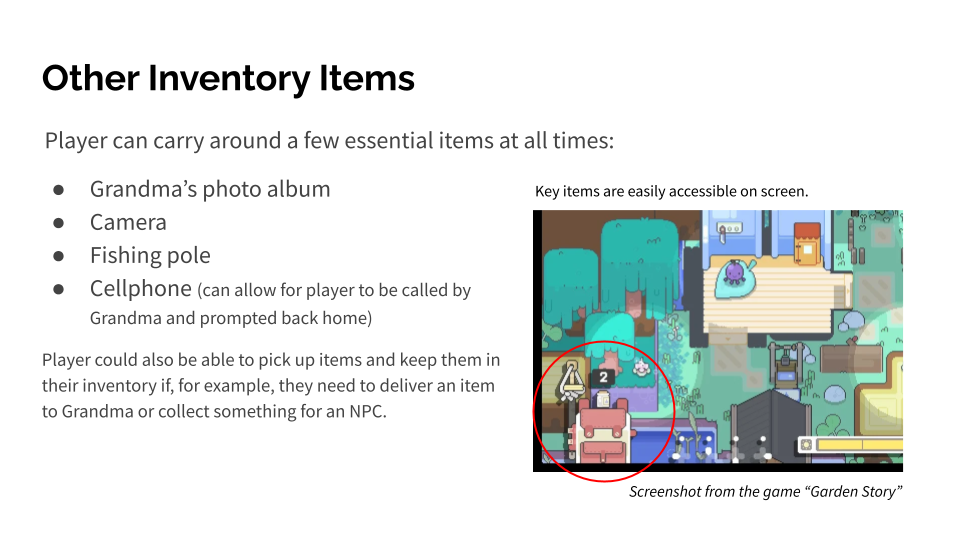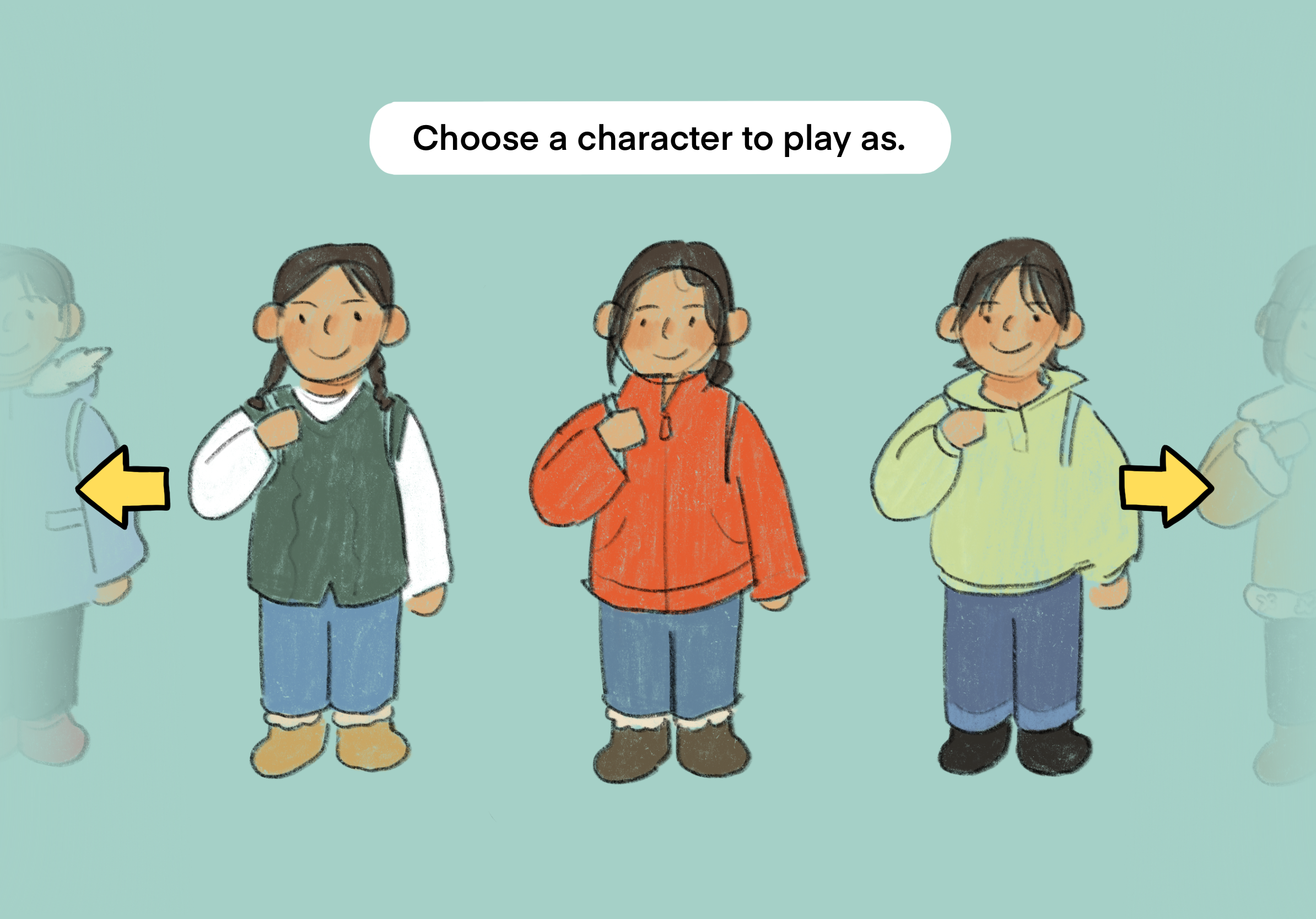“Sharing the Catch”: Alaskan Indigenous Climate Change Simulation Game
Game Design for GBH Digital
Role
Games & Interactive Software Intern
Skills
Design • Research • UX
Team
3 interns, 1 mentor, 2 indigenous advisors
Outcomes
Educational video game design for GBH product proposal.
The Problem
Alaskan students – including those in indigenous communities – do not have awareness of the damage that climate change is inflicting on Alaskan environments and indigenous populations.
The Users
Classrooms of 9 to 16-year-old students
Solution
Educational video game that allows “first-hand” interaction and immersion.
Research & Objectives
Alaskan students do not have awareness about many forms of environmental and cultural degradation.
The game must present key problems Alaskan indigenous communities face and the relationship between environment and culture.
Many problems communities face are highly influenced and contextualized by political and social external factors.
While it may not be able to assign responsibility, determine solutions, or measure impacts, the game must recognize – not dismiss – context.
The greatest obstacle to climate action is the impression of physical, temporal, and causal distance.
In order to inspire action, the game must emotionally immerse the player and convey a strong sense of urgency through narrative and gameplay.
Games, especially for 9 to 16-year-old students in a classroom, need to be enjoyable.
The game must be compelling and fun, being impactful without being demoralizing or discouraging.
Numerous different tribes make up the Alaskan indigenous population, each with different lifestyles and cultures.
While the game must focus on the population as a whole, it must not misrepresent communities through generalization.
Narrative
You visit your grandmother’s home for the week, but the villagers are too busy for conversation and some community members are not in town. As a result of warming weather, fishing and berry seasons are overlapping, leaving the community busy preparing and storing food.
Your grandmother gifts you her old photo album. With ample free time, you begin to explore the areas of her indigenous hometown on a quest to reimagine some photos from her youth. As you venture on this journey of nostalgia, you begin to discover more about the community and the changes in climate that are threatening it.
( All concept art illustrated by me. )
Player
The main character is designed to be as relatable and immersive as possible to the student player.
Roughly 13-year-old protagonist
Gender-neutral character designs
Pronoun choice
Concept. Discover Climate Change Through Photography
Grandma’s Photo Album allows the player to have interactive visits to the past and experience the scenes that Grandma photographed many years ago.
But, when the player makes their way to the same places, things look very different.
Simple game mechanism
Compares past and present to providing information about environment damage
Motivation for “first-hand” discovery and investigation
Reflects the amnesia associated with complacency and inaction
Temperature and snowfall change.
By allowing the player to realize what has happened to the community together with the main character – rather than it being laid out for them – the game creates emotional investment and urgency.
Low fish count and fishing site loss from retreating glaciers.
Gameplay
Tasks
Tasks educate players on various topics. Every day, the player completes 2 tasks.
Tasks are prompted by entering new areas, interaction with a character, etc.
Every task relates to a photo in Grandma’s Photo Album
Completion of a task results in a new photograph taken by the player
At the end of each day, the player returns home for dinner with Grandma and reflects on what they learned from the day’s tasks
Example Task Sequence: Fisherman needs help fishing.
This task addresses the decreasing sizes of fish caught due to early migration into Alaskan indigenous areas. The player experiences this change and can learn about the causes from Grandma at the end of the day.
Game Structure
The game is comprised of 5 days or 10 tasks. This structure is coupled with The Cellar, a larger task that spans across the 5 days.
Exploring climate degradation that has occurred over decades may communicate that solutions are not urgently needed. The Cellar, however, demonstrates tangible change over the player’s 5 days and emphasizes the urgency of climate action. The player may not notice changes to cellar as they are only indicated visually, until the warmest day when the player receives a rude awakening that change is occurring right under their feet.
The Cellar Task Sequence: Retrieve fish from the cellar for dinner with Grandma every day.
The Cellar reflects the impact of warmer temperatures with 3 days of increasingly warm days before the relief of a colder day. This shows the thawing of permafrost and its effects on availability and preservation of food.
Further Recommendations for the Proposal
Incorporating the following cultural context into plot and character dialogue:
Gratitude & thanks: The focus on gathering food is not to maximize but to take simply what is needed and respect the needs of others. Expressing gratitude to the sources of food is important.
Local food sources: Importation of food is very expensive because food must be flown into the Alaskan communities by plane, so local fishing and gathering is crucial to livelihood.
Language: Many of the indigenous languages spoken in Alaska are only spoken by a small populations of people that keep it alive. Incorporating language into location names, character names, dialogue, etc. can teach Alaskan students some of these words and languages.
Tasks that address issues like the following:
Thinning ice: Helping someone with a snowmobile that fell through thin ice
Communities & Policy: Villager who was away returns with news of village relocation, government policy news, etc.
Loss of Fishing Sites: Communities are limited in fishing spots and have gathered in select areas
Feedback
On the last day we presented to GBH’s Head Producer, the indigenous Advisors for the game proposal, Directors, and GBH Digital’s Games & Interactive Software team.
The advisors, indigenous Alaskan natives, expressed gratitude for our care and meticulousness in addressing the cause through a potently emotional and impactful game.
We were praised for creating such a thorough concept in the short time of 2 weeks.
The team was impressed with the presentation, as the diagrams mapping story, functionality, and game structure would serve as a great standalone documentation for reference.























Reflection
Collaborating with two fellow interns, my work involved anything from making key decisions regarding game mechanics and gameplay to building a compelling narrative, visual theme, and storyboard. Empathy, listening, and cultural intelligence were essential on top of design, problem solving, user-thinking, and systems thinking.
I was able to experience the iterative process of ideation, collaboration, and refinement, and each of us was able to contribute our diverse backgrounds and knowledge. My GBH mentor also acknowledged that I played a major role and displayed skill in thinking about user experience, interactivity, and how to elicit an emotional response or shift in mentality from a player.
This is still one of my favorite projects to date. I felt that I was able to contribute my perspective as a visual artist, as a developer, and as a new learner to Alaskan indigenous environments and culture myself. It was heartwarming to know that we had created solid beginnings to a game that would have immense impact on Alaskan students, environmental awareness, and representation of Alaskan indigenous culture.







